Jet bridge, also given many other names such as Passenger Boarding Bridge, Aviobridge, Aerobridge, Air Bridge, Jetway or Jetty, is one of the most important ground support equipment (GSE).
Today’s article is dedicated to explaining the jet bridge in great detail. By the end of this article, you are going to have a sound technical understanding of jet bridge.
What is a Jet Bridge?
When an airplane lands at an airport, after passing through the runway and taxiway, it finally reaches at a place called an Aircraft Stand (also referred to as an aircraft bay). This is the place where passengers leave the airplane and enter airport building and this is where a Jet Bridge plays its role.
A Jet Bridge is simply a bridge on wheels that connects the airplane door with airport building. It is a movable structure powered by electric motors or hydraulic system for its movements and adjustments. It is also fitted with different types of sensors installed for safety of the bridge, airplane and people moving on ground around it. We will discuss more about the design of Jet Bridge later in this post.
History & Necessity of Jet Bridge
Airplane doors are at such a height that you need some sort of assistance to allow people to enter or leave the cabin. Historically, mobile aircraft stairs (also known as mobile steps) were used for this purpose.
A mobile aircraft stair is simply a staircase on wheels that adjusts its height with different aircraft types to align its level with the aircraft door and provide a safe passage to passengers to board or deplane the cabin.

However, mobile stairs do not protect the passengers from rain and bad weather. Nor do they offer any convenience in extreme hot summers. Moreover, it is not possible for mobile stairs to facilitate deplaning of passengers that need special care especially wheelchaired passengers.
The Jet Bridge was invented by Frank Der Yuen, an aeronautical engineer from MIT, born in 1912 and died in 1984. He patented the concept of jet bridge in 1962.
The purpose of a Jet Bridge is simple. It is to provide such a connection between aircraft and airport building that allows passengers to be embarked and deplaned from an aircraft in a comfortable and convenient manner that also requires less time and improves efficiency.
The concept of mobile bridges for passengers is not limited to aviation industry. Boarding bridges are used for passengers of a cruise ship as well as astronauts going on board on a rocket.
Jet Bridges make quite a weatherproof connection with the aircraft such that passengers are not exposed to outside weather conditions. It has its own air conditioning system to keep the bridge warm in winters and pleasant in summers.
Since a Jet Bridge connects at the same level as an aircraft building, it makes the activity of entering and leaving aircraft comfortable for wheelchaired passengers, senior passengers as well as other physically challenged passengers.
Apart from above reasons, exiting the airplane through mobile stairs and waiting for the bus to carry you to the desired airport gate can be a pleasant experience to someone new to the flying as you feel excited about looking at the airplane and all the activity that surrounds it from somewhere other than behind an airport window.
However, for frequent flyers or people uninterested in airport environment, it is not a pleasant experience because the weather is either too cold or too hot most of the times and there is a lot of noise at an aircraft stand. Passengers often complaint about the airline service if jet bridge is not used on the flight.
Have Jet Bridges Eliminated Mobile Stairs?
Although Jet Bridges have become the standard way of embarking and deplaning passengers, mobile stairs have not gone extinct. Every airport has a certain number of aircraft stands (or bays) that are called remote stands (also called hardstands or hard bays). They are given that name because they are located farther away from airport terminal building. These stands do not have the facility of jet bridges.
You may wonder why would an airport intentionally keep such an arrangement where jet bridges are not used?
The reason is that jet bridges occupy greater space as compared to no jet bridges. They also require greater infrastructure in construction of a gangway – an extension of airport building constructed especially for installation of a jet bridge (a handshake concept where the terminal building extends to reach the jet bridge while the jet bridge takes care of the path up to the aircraft door).

Consequently, airport gates that have jet bridges on them have to be constructed farther away from each other to accommodate the jet bridges and their supporting civil structure. That means less airport gates per given area because each gate is taking more space. That in turn reduces the overall capacity of an airport terminal building to accommodate maximum number of airplanes at any given time and that ultimately can translate to less money-making potential.
Due to the above reasons, when an airport is being planned and designed by consultant firms, they have to make a profitable compromise between quality of service and capacity of airport to accommodate as many flights as possible. This necessary compromise presents itself in the form of a preplanned split between contact stands (with jet bridges) and remote stands (without jet bridges) at the airport.
Remote stands are used by budget airlines trying to save on the expenditure by cutting jet bridge costs. In case of abundant traffic of flights, airport authorities may also provide jet bridges on first come first serve basis where the remaining flights may be accommodated on hard bays instead of waiting for an already occupied jet bridge to become vacant.
Moreover, hard bays are also used for parking private jets, business jets, cargo aircrafts and helicopters since they don’t have compatible jet bridges.
Main Components of Jet Bridge & How They Work
Now that we have looked into the history and necessity of jet bridges as well as their importance at an airport, let’s look at the jet bridge from a scientific perspective in terms of its basic components and working.
Different manufacturers use different nomenclature for different parts and components of their jet bridge. Therefore, the terms we have used in this post may slightly differ from a manufacturer’s manual, however, the concept will largely remain the same.
Things are about to get a little technical from here so bear with us.
There are 5 main components of a jet bridge namely Rotunda, Telescopic Tunnels, Elevation System, Cabin and Traction System.
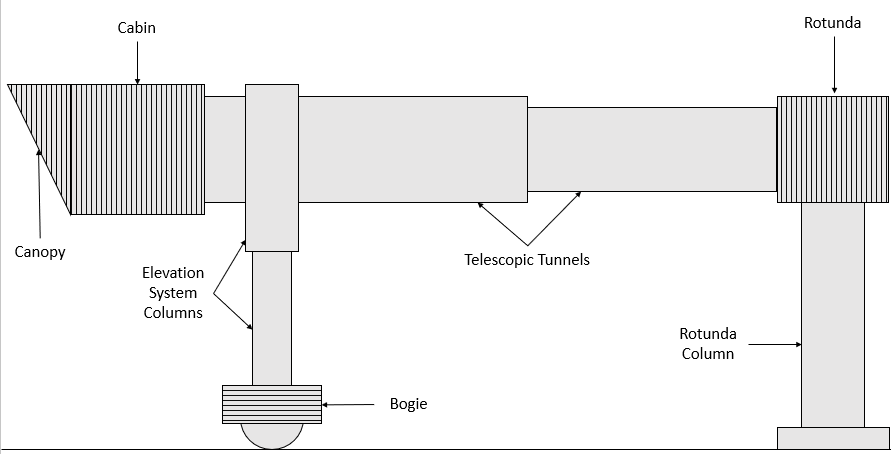
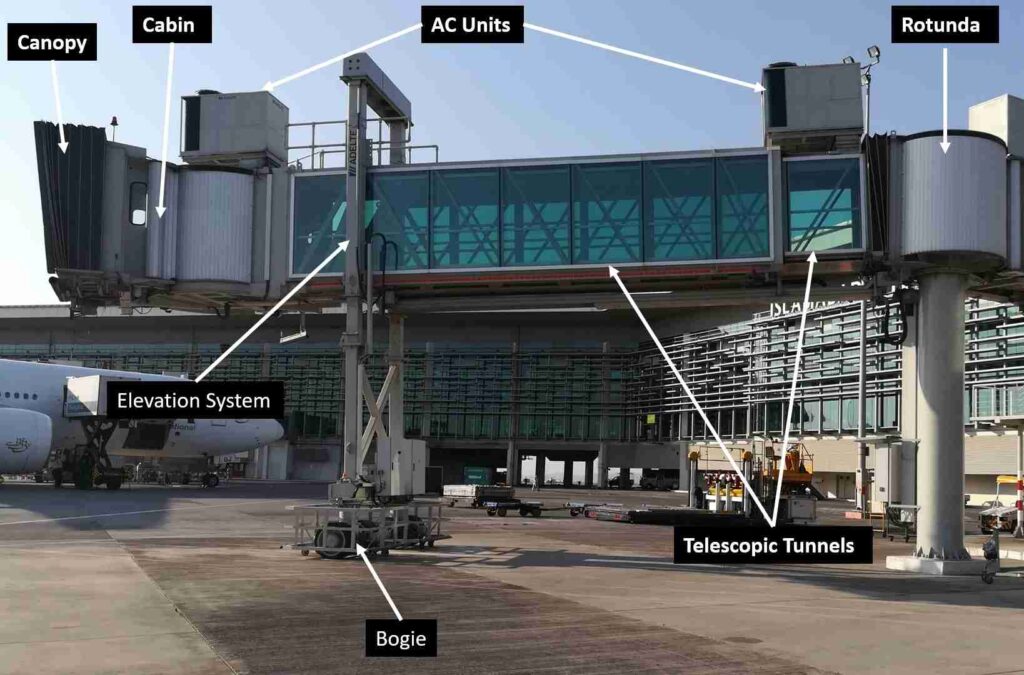
A Jet Bridge starts with a Rotunda fixed over a Rotunda Column anchored into the ground. The function of rotunda is to act as an interface between airport building (a civil structure) and mechanical bridge (movable structure). Rotunda column serves as a strong foundation for the remaining parts of the bridge to be assembled over.
The interior of rotunda is designed to give it the same feel as airport building so that passengers don’t feel any difference. Its floor is fitted with carpet and roof with neat panels. Its circumference is installed with aluminum slats.
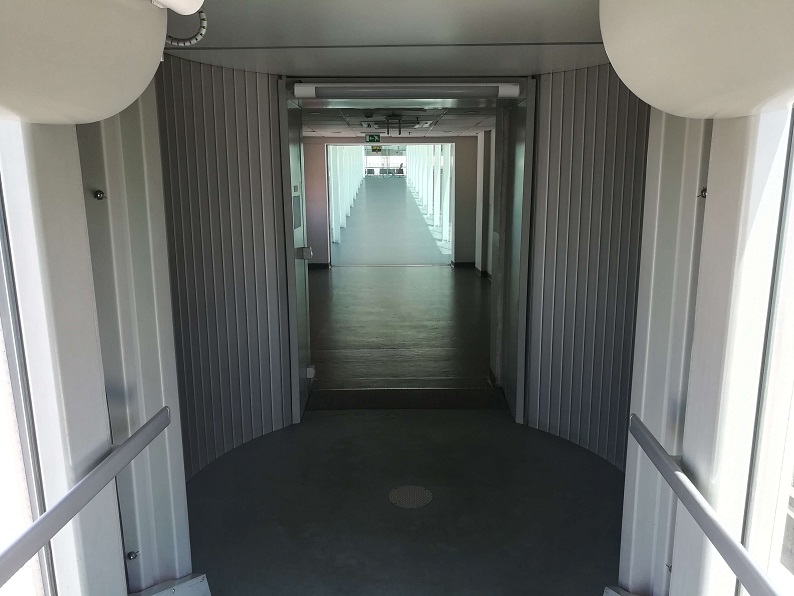
Telescopic Tunnels are the next part of bridge. They are supported by rotunda on one side and an elevation system on the other (we will discuss elevation system shortly). Telescopic tunnels are what make it a bridge.
The tunnel directly connected with rotunda is called a rotunda tunnel while the tunnel directly connected with cabin is called cabin tunnel (cabin will be explained shortly). Many jet bridges have more than 2 tunnels where intermediary tunnels are assembled between rotunda and cabin tunnel.
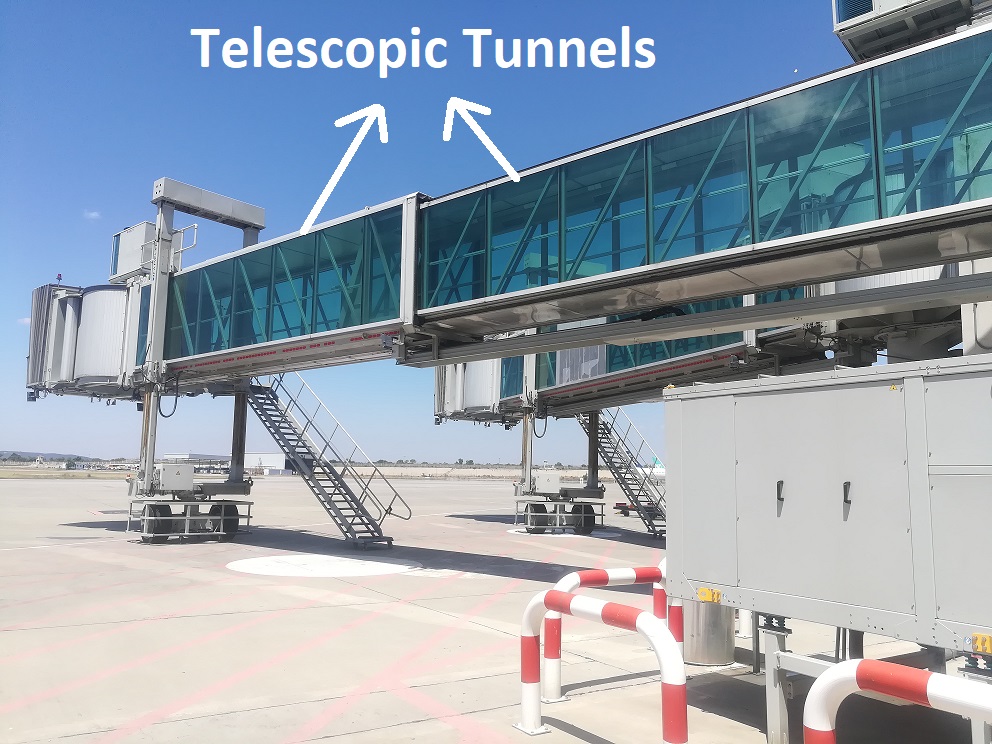
The term ‘telescopic’ is important here. Just like a telescope can be collapsed into a shorter length, the tunnels on a jet bridge slide inside one another to reduce overall length of the bridge. When all passengers have embarked on the airplane for departure, jet bridge telescopically collapses to draw back from the aircraft and create a safe separation between itself and aircraft fuselage.
Moving forward, the cabin tunnel is supported over an Elevation System. It comprises two metal pillars or columns side by side, assembled over a bogie (to be discussed shortly). Each column is actually a telescopic column with the ability to collapse or elongate.
The telescopic tunnels are fastened on both sides with these columns and telescopic action of these columns translates into raising or lowering the whole bridge to make it level with the aircraft.
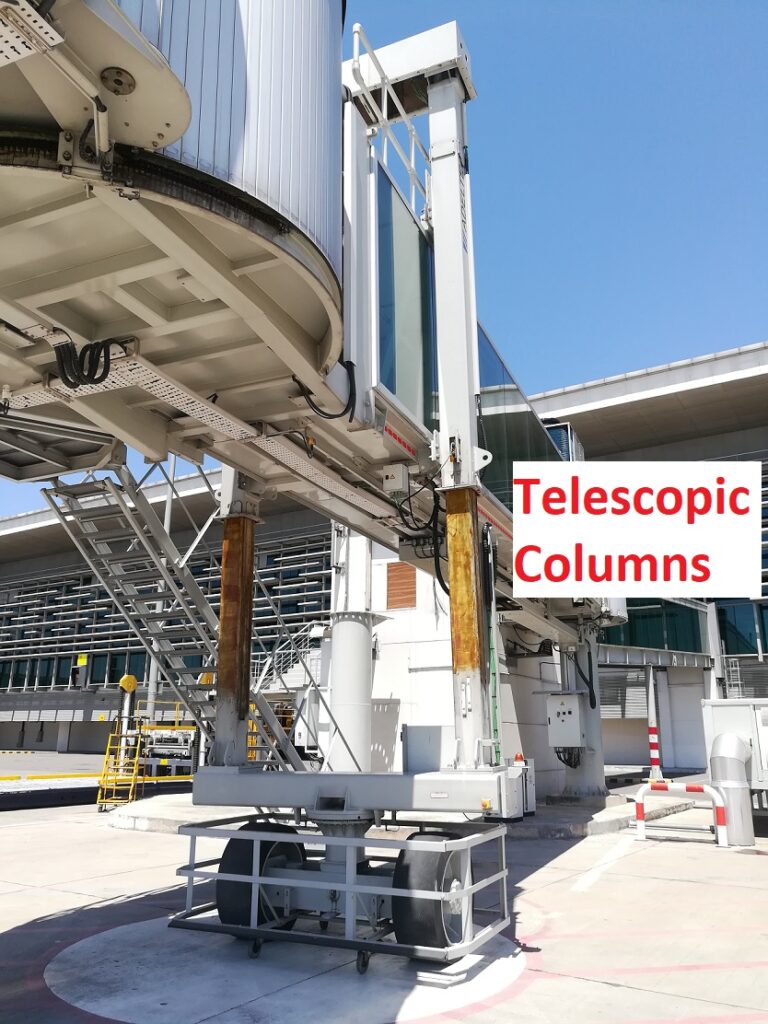

This telescopic action is driven either hydraulically or mechanically. Jet bridges having hydraulic system to power their elevation system are called hydraulic bridges while those in which this elevation system is powered mechanically are called electro-mechanical bridges.
If you are wondering why there is any need to elevate or lower the bridge, let us give an explanation.
Since different aircrafts have different geometries, a single aircraft stand is designed to accommodate not one but a group of aircrafts. It is therefore imperative that a bridge designed to connect airplane door with airport building must be able to chase that door in different types of big and small aircrafts.
The aircraft door will be higher on some aircraft than the other parking on the same aircraft stand. Therefore, elevation system is a primary design feature of jet bridge that makes it compatible with a group of aircrafts arriving on the aircraft stand.
The elevation system columns described above are assembled over something commonly referred to as the ‘Bogie’. It is technically called the Traction System but is given the name ‘Bogie’ due to its likeness to locomotive bogie.
Bogie in jet bridge is responsible for all ground movements of the bridge. It mainly comprises two large wheels with each wheel having an electric motor and gearbox coupled to it for producing rotation. Both wheels move independent of each other.
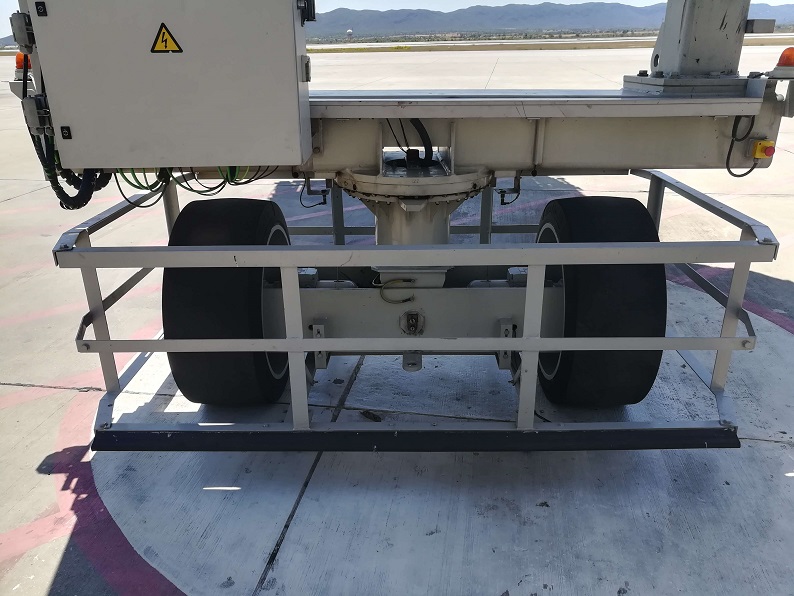
When jet bridge has to be moved forward, both motors are energized by an electronic command given by bridge operator (like pushing control joystick forward). Similarly, a reverse command is given to rotate motors in opposite direction to move the bridge backwards.
The sideways movements are interesting because bogie wheels do not turn like wheels of a car do where you simply use a steering wheel to change the angle of your wheels and push the gas pedal to move in the new direction. Bogie wheels cannot change their angles because they are fixed.
The electronic control system of the jet bridge uses an algorithm to produce rotation. It energizes one motor in forward direction and the other motor in backward direction. The result is that the whole bogie starts to rotate in a clockwise or anticlockwise direction.
Once the angle of the bogie has been set as desired, operator gives the forward command and bogie starts moving forward in the newly assigned direction while carrying the whole bridge with it. Under such a case, the rotunda acts as a pivot or center of the circle in which bogie is moving.

Just like elevation system is responsible for making the level of jet bridge in line with the level of aircraft door, bogie is responsible for moving the whole bridge forwards towards the aircraft during arrival flights and reverse away from the aircraft during departure.
Remember we discussed the telescopic tunnels above that how they elongate and collapse?
The telescopic tunnels do not have any motors of their own to make them elongate or collapse. It is the bogie who does that. As the bogie moves forward, it elongates the telescopic tunnels. As the bogie moves backwards, it collapses the telescopic tunnels.
Bogie is therefore one of the most important parts of a jet bridge that is actually imparting it the ‘mobile bridge’ ability.
We hope we are able to explain technical things in easy to understand way so that you don’t feel you are being overwhelmed by technical jargons. Let’s move forward to the last part of the jet bridge.
At the end of the telescopic tunnels is the Cabin. Cabin is the part of the jet bridge that makes the final contact with the aircraft and makes the whole concept of ‘bridge’ possible. From the outside, cabin looks similar to rotunda i.e. a cylindrical shell, however, there is no pillar under it.
The role of cabin in a jet bridge is analogous to the role of cockpit in an airplane.
Cabin is fitted with the Operator Panel from where all movements of the jet bridge are controlled. The operator panel of modern jet bridges is very intuitive with a display screen, a few buttons and a joystick to maneuver the bridge.

The display screen shows the most important pieces of information to the operator including alarm messages, error codes and all parameters required for controlling the movements of jet bridge.
These parameters include the percentage extension of telescopic tunnels to make the operator aware of how much he has extended the bridge; the percentage extension of elevation system telescopic columns to make the operator aware of height of the bridge and angles of bogie, rotunda and cabin itself.
The joystick is similar to gaming console joysticks where the operator simply moves the stick in the direction he wants the bridge to move and the bridge’s control system translates that motion of joystick into electronic commands to electric motors of bogie to energize and move the bogie wheels in that direction.
There are three parts of cabin that play the most important role with respect to making engagement with the aircraft. These are cabin bumper, canopy and auto leveler.
Cabin Bumper is a cylindrical rubber located just at the bottom most protruded end of the cabin. It is intended to provide a soft scratch-free physical engagement between jet bridge and aircraft fuselage.
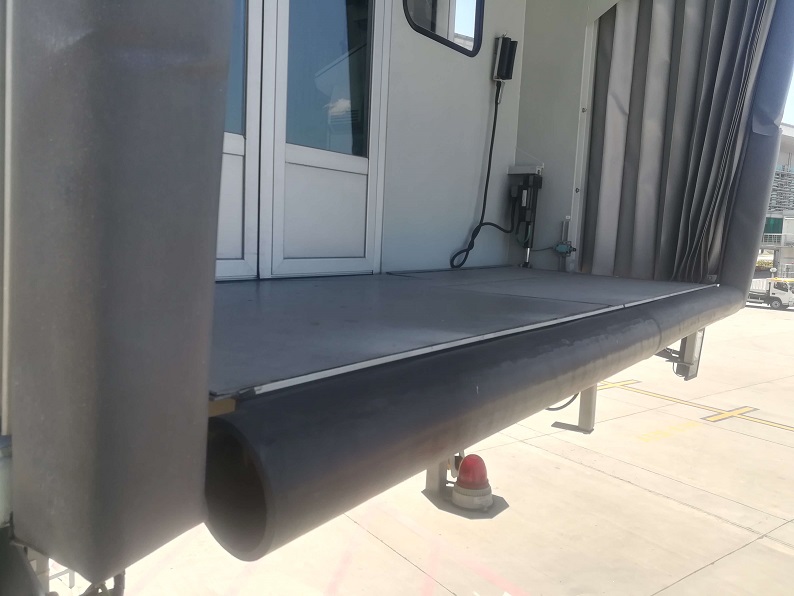
The operator maneuvers the bridge to make the cabin align with the aircraft door. During this alignment, operator has to precisely align the cabin bumper under the aircraft door such that when passengers step outside of the airplane, there is no gap between the aircraft door and cabin bumper in which someone’s foot could slip into.
To make sure such a gap isn’t present, the operator either softly touches the cabin bumper with the aircraft body allowing the rubber to compress a little and produce no mark or scratch on aircraft body or the operator keeps just a hairline gap between the bumper and aircraft body.
Apart from above, operator must not lower the bridge so much that the cabin is so much lower than the aircraft door that as the passengers step outside the aircraft, they feel they are stepping down a big step.
An expert and skilled operator will align the cabin bumper under the door of the aircraft such that passengers don’t feel they are stepping into a different platform as they exit the airplane door.
After cabin bumper has been properly engaged, the operator must engage what is known as the Canopy. As the name implies, canopy acts like a roof completely engulfing the exit door of the aircraft to prevent the exiting passengers from getting exposed to external weather.
Canopy is made of water proof fabric with padded ends to avoid any scratching on aircraft body as it makes physical contact. It is supported by belts passing over a roller driven by electric motors. These motors rotate in one direction to allow the canopy to fall forward and engage with the aircraft.
Similarly, motors rotate in opposite direction to pull the canopy back to its home position at the time of aircraft departure.
Since it is made out of fabric and padded material, it molds into the curvature of aircraft body and makes a proper seal around the aircraft door. It prevents rain, snow, dust, sunlight and wind from affecting the passengers exiting the aircraft. Moreover, it also saves losses in the internal air conditioning of jet bridge. It plays an important role in fulfilling the ‘protect passengers from outside environment’ part of the bridge.
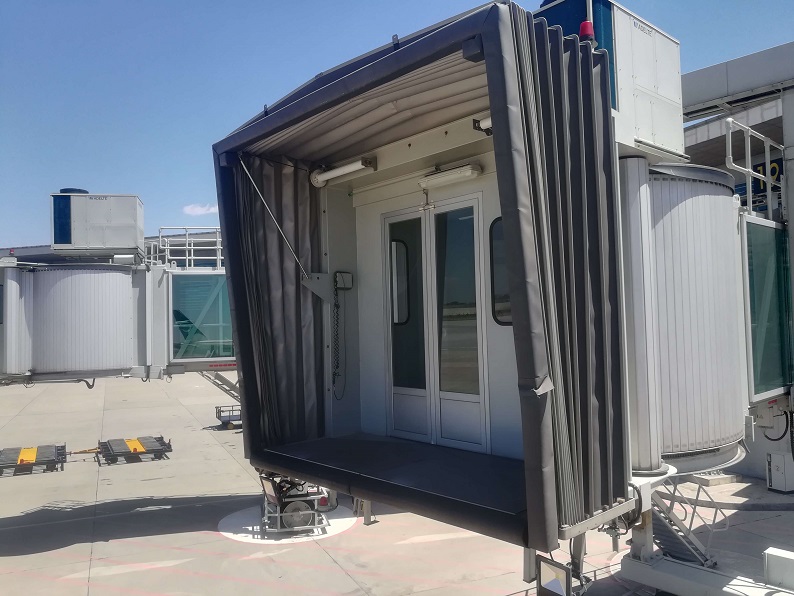


After engagement of canopy, the last thing an operator does to complete arrival operation of jet bridge is to activate the Jet Bridge Auto Leveler.
Before we explain what an auto leveler is and what it does, let us explain what happens after jet bridge has been engaged. The key to understanding the important role played by auto leveler is in understand the dynamics of ground operations.
After an aircraft is parked at the aircraft stand and jet bridge is engaged, it is not only the passengers that exit the airplane. Their baggage and other cargo are also unloaded from the cargo compartment. So basically, a lot of load is being taken off the airplane.
To get this into perspective, a small passenger airliner like an Airbus A320 can easily carry over 100 passengers onboard. If each passenger weighs 75 kg (165 lbs.), combined weight of passengers alone is 7.5 metric tons. Add a few tons for their combined baggage and cargo as well and you can safely assume that an aircraft’s total weight reduces by 10 metric tons in the time duration is remains parked at an aircraft stand.
Just like your SUV rises up when you remove heavy luggage from its trunk, the aircraft’s height also changes when 10 metric tons of load is removed from its landing gear. It rises up!
What do you think will happen with the alignment of cabin bumper we discussed a few paragraphs above?
It is obvious that the aircraft body will rise but jet bridge will remain at the same height. It will create difference of height in airplane door and jet bridge level – something that is undesirable.
So, what is the solution? Should the operator keep adjusting the jet bridge’s height time and time again?
This is where the auto leveler comes in. As the name suggests, auto leveler is a sensor based assembly installed on one side of the cabin that allows the bridge to automatically adjust its level to the height of the aircraft.
It senses whenever aircraft changes height and automatically activates the elevation system of the bridge to maintain level of bridge with the aircraft door. In this way, once an operator has aligned the cabin bumper and canopy properly with the aircraft, bridge take it upon itself to maintain that alignment with the help of the auto leveler.

We will get into the engineering behind the electromechanical design of auto leveler assembly later in a separate post, however, the basic principle is that an arm and wheel assembly controlled by an electric motor and fit with sensors makes contact with the aircraft body.
As the aircraft rises, the wheel rotates and sends a signal to the jet bridge’s control system to make it aware of the change in aircraft height. The control system activates the elevation system to change bridge’s height until the wheel rotates back to its home position. As soon as the control system receives this signal, it stops further elevation. This is how an auto leveler maintains the height of the bridge at the same level as that of the aircraft.
Modern Technology in Jet Bridges
Jet bridges comes with many different technological features to protect not only the aircraft from possible accidents but also the ground handling and airline staff moving around the bridge to carry out different servicing tasks and activities in ground handling operation.
We are going to explain some of these technologies.
The Dead Man Switch
Another technological safety system used in jet bridges is the use of a dead man’s switch in joystick that controls the movement of the bridge. It is simple to understand its function.
The joystick won’t work until a lock is kept activated by the jet bridge operator. The lock is spring loaded and if the operator does not consciously keep pressure over it, it will release by itself and disable bridge movement irrespective of the direction in which joystick is being pushed. The dead man’s switch prevents unintentional movement of the jet bridge.
What can such unintentional movements be?
- The operator can lose control of himself during jet bridge operation due to any emergency health situation.
- After bridge engagement, any staff leaning against the jet bridge control panel may accidently push the joystick.
- During passenger boarding or disembarkation, any child passenger may grab the joystick and move it.
Therefore, dead man’s switch serves as a simple yet effective safety measure in jet bridge operation.

Aircraft Contact Sensing
To prevent collision between the aircraft and bridge, the cabin bumper is fitted with special sensors that detect if the rubber bumper is being pressed too hard with the aircraft body. These sensors detect the change in bumper shape as it is pressed between the bridge and the aircraft body.
As soon as the sensors detect this ‘pressing’ action, they send a signal to bridge’s control system that disables forward movement of the bridge even if the operator is pushing joystick forward.
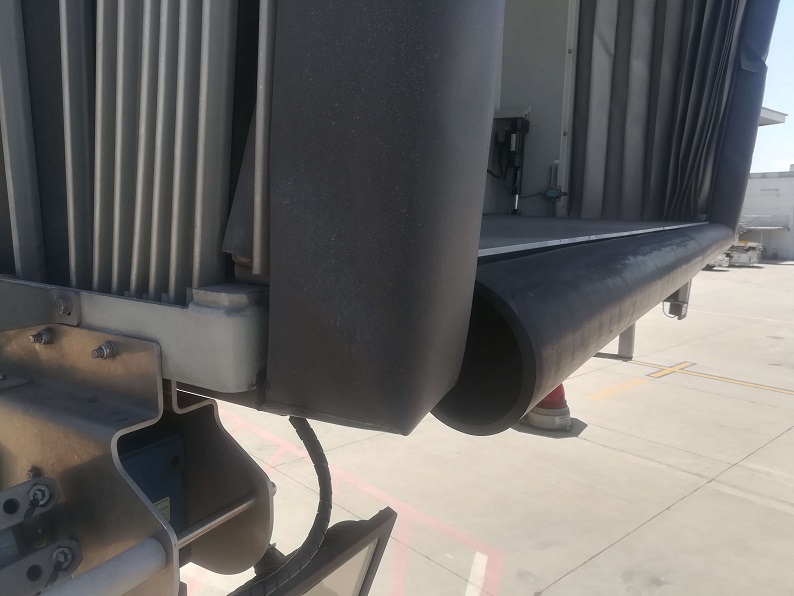
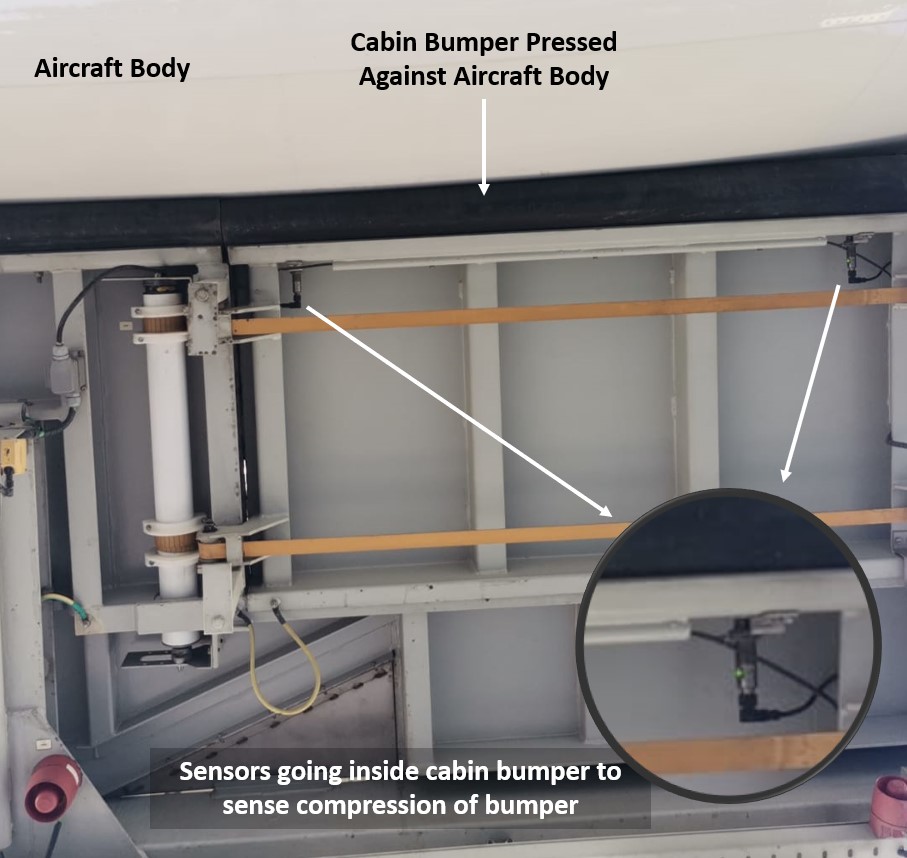
Aircraft Proximity Sensing
Even before the jet bridge makes physical contact with the aircraft, some jet bridges also have Aircraft Proximity sensors to detect if the cabin is in close proximity to the aircraft body. If it is, these sensors send a signal to the bridge’s control system and the control system automatically limits the forward movement to lowest speed even if operator is pushing the joystick forward all the way. This safety system makes sure the bridge approaches the aircraft body very slowly to reduce risk of accident.
Wheel Bogie Obstacle Sensing
For the airline and ground handling staff present near the bogie, a special cage is available in some bridges to prevent running over a person or object. Where a cage is not available, a fence or some other form of protection is always kept.
Moreover, a special sensor system similar to cabin bumper sensor are also installed over the bogie that detects if something is coming in the way of bogie movement. The sensor sends a signal to the bridge’s control system when any human or material obstacle is felt and the control system disables any further movement. This safety system is basically a runover protection for people and objects moving on the ground around a jet bridge.
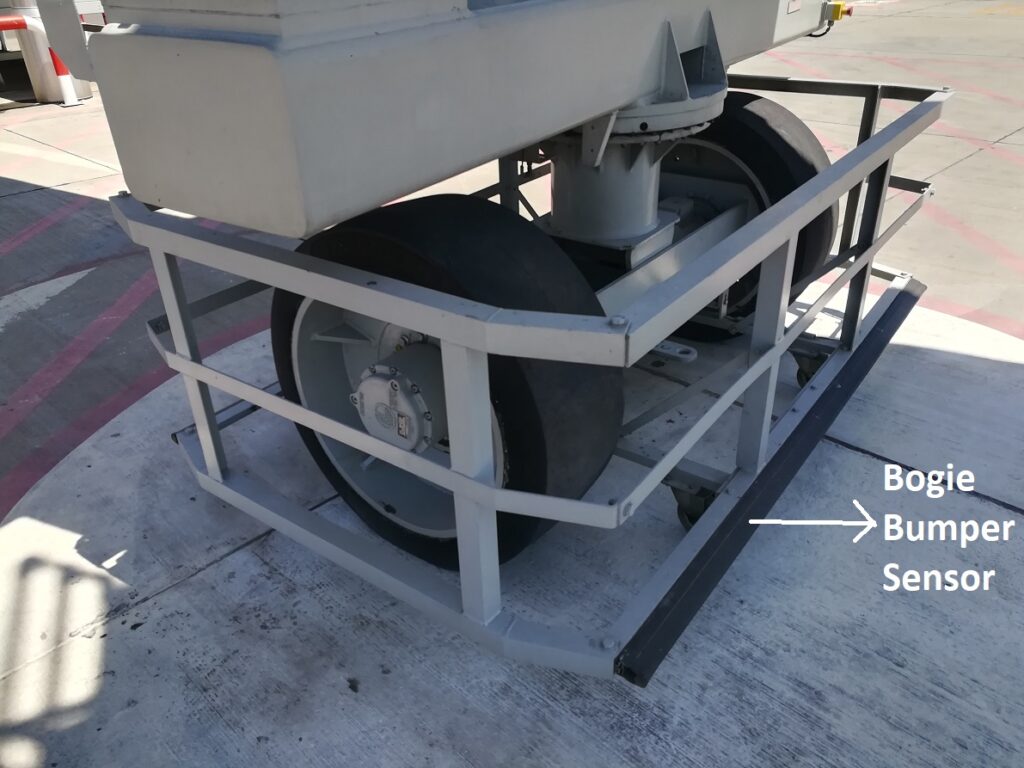
Anti-Collision System on Dual Jet Bridges
Where multiple jet bridges are installed on an aircraft stand to engage with both 1L and 2L doors of the aircraft at the same time, they have special sensors to detect the distance between the two bridges.
These sensors detect if the two bridges are coming too close to each other posing a risk of collision and send a signal to the bridge’s control system that disables any further movement towards each other. It is called an anti-collision system.

Auto-leveling Failure Backup
A special safety system is in place for fool proofing auto leveling system as well. It is called a ‘Safety Shoe’. It is a sensor assembly placed under the door of the aircraft on the floor of jet bridge cabin. It produces an alarm if the aircraft height is reducing during loading of cargo and passengers but jet bridge’s auto leveling system is not lowering the bridge.
Under such a scenario, the aircraft door presses the safety shoe placed under it and the safety shoe sends a signal to jet bridge’s control system that something is wrong. The jet bridge starts producing a loud alarm, drops a special platform to protect the aircraft door and automatically pulls the canopy back Basically, jet bridge tries to alert everyone around it that something needs serious attention.
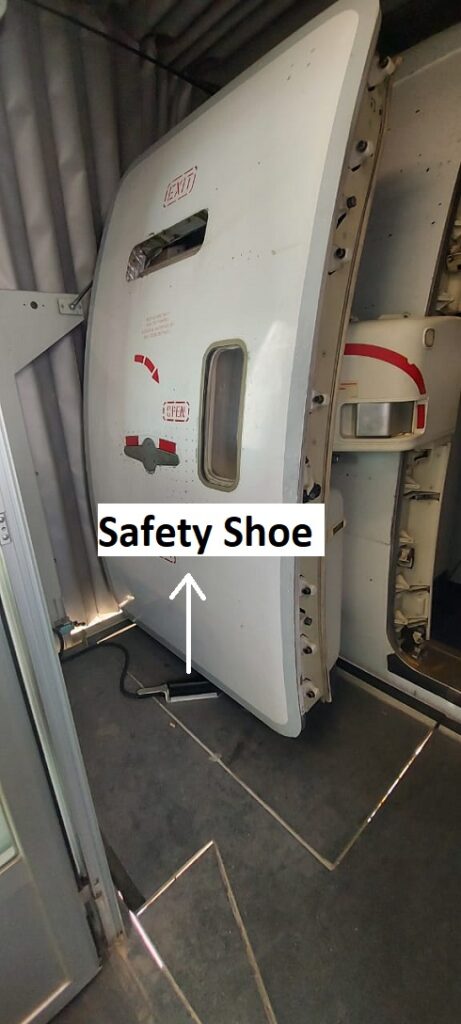
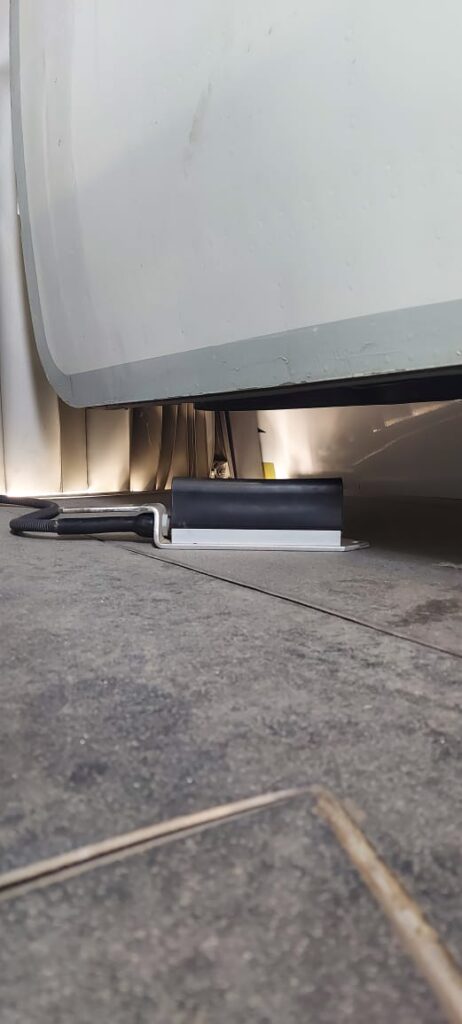
Passenger Door Closure Sensing
Another important safety feature that needs to be mentioned is the cabin passenger doors safety system. The passenger doors on jet bridge are opened by the operator when jet bridge has been safely engaged with the aircraft door. These doors are closed after embarkation of passengers is complete and the jet bridge needs to be disengaged.
The door safety system comprises sensors that sense whether these doors are open or close. If the doors are not closed, the jet bridge control system disables any movement of the jet bridge. This safety system makes sure that a bridge is disengaged from the aircraft only when passenger movement is finished and these doors are closed.

Automatic Positioning or Prepositioning in Jet Bridges
A discussion on jet bridges cannot be complete without explaining the latest advances in jet bridge technology. Just like automation has become the next big thing in automotive industries in the form of self-driving cars, aviation technology has also been touched by automation.
Almost all major manufacturers of jet bridges are developing models capable of ‘self-driving’, however, the term commonly given to this type of operator-less automation in jet bridge industry is ‘Pre-Positioning’.
Pre-positioning in jet bridges refers to the functionality in jet bridge to operate itself and engage or disengage with the aircraft. All the movements that are performed by the operator in a manual operation are performed by the jet bridge itself when pre-positioning functionality is used.
Can you guess how pre-positioning would work? Maybe jet bridge has a camera that identifies the type of aircraft and move itself towards its door adjusting the cabin and bogie angle along the way with the help of sensors? No. It is easier than that.
Pre-positioning function can be set up only after jet bridge has been installed at an airport on an aircraft stand. The engineering team takes the geometry of all the different types of aircrafts the aircraft stand is designed to accommodate and figure out the parameters to be set inside jet bridge’s control system for making the cabin reach the level of aircraft door.
These parameters mainly include percentage of telescopic tunnel extension at which the cabin reaches the aircraft body and percentage height of telescopic columns of elevation system at which the cabin level becomes same with the level of aircraft door.

These parameters are calculated separately for all the aircrafts for which that aircraft stand is designed and the function activates when the operator selects an aircraft type from the operator panel interface. Moreover, operator has to remain inside the cabin during the whole operation to interrupt the pre-positioning functionality if he feels something is going wrong.
The operator’s presence is not kept just for monitoring and safety purposes. Pre-positioning function is not given complete freedom to engage cabin with the aircraft door. It is configured in a way so that the jet bridge reaches close to the aircraft and stops. It still keeps the operator’s job alive as operator makes the final touches and finishes the job.
Human supervision is necessary due to safety reasons. For example, it can be that the aircraft parked a little ahead of its stopping position or a little behind it. Pre-positioning system wouldn’t know the difference and would try to engage the jet bridge as if the aircraft is at its designated stop position and it may cause an accident.
You may wonder what is the advantage of pre-positioning when the operator has to remain inside the cabin as well as perform the final touches?
Although pre-positioning does not completely eliminate the need for a bridge operator, it significantly reduces human involvement such that more than 90% of the work is carried out by machine and 10% by human operator.
By reducing human involvement, pre-positioning reduces chances of human error and also saves time. A human operator relies on his judgement each time he engages the bridge with an aircraft. On the other hand, machine relies on simple math and minuses a big chunk of ‘human judgment’ factor from jet bridge operation that saves time.
So, this was it from our side. If you like this article, do leave your valuable feedback and share it with people interested in aviation technology. Let us know in the comments if you think we have missed something or something could be improved.
If you are interested in obtaining a base level knowledge about all the different types of aircraft ground support equipment and operations, Check out this 3 Hour video based course on Udemy that explains each of nearly 20 different aircraft ground support activities and equipment.

